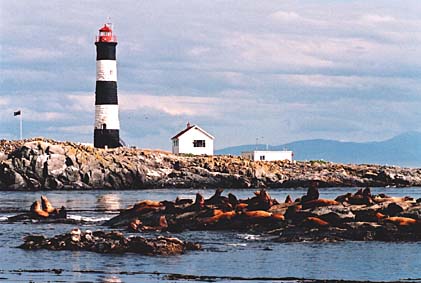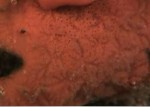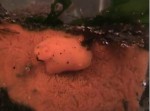Going with the flow
A UVic study explores renewable energy options at Canada’s newest Marine Protected Area
by Diane Haughland

Taco Niet
The essence of Race Rocks is its tides. Tides that feed biodiversity. Tides that have brought ships to their knees upon its rocky shores. And tides that may bring it to the forefront of renewable energy technology.
For his recently completed master’s thesis, UVic mechanical engineering graduate student Taco Niet has created a model that shows tidal power to be the most realistic source of renewable energy for Race Rocks.
A collection of nine tiny islets with a big reputation, Race Rocks is situated 17 km southwest of Victoria at the eastern end of the Strait of Juan de Fuca. Its reefs and strong tidal currents — up to seven knots — support an exceptional diversity of marine life, including invertebrates, fish, seabirds and marine mammals. In 2000 it became Canada’s first Marine Protected Area created under the federal Oceans Act.
Race Rocks hosts a lighthouse, occasional researchers and educators, and two full-time guardians employed by Lester B. Pearson College. The college has also installed a local area network that allows Internet video coverage around the clock, accessible at www.racerocks.com.
While the light tower and foghorn are powered by solar panels, a diesel generator supplies the guardians with the energy required to live full-time at Race Rocks, including energy-costly water desalination. Several times a year, diesel fuel is transported to the island by boat and pumped into storage tanks, an enterprise with plenty of potential environmental hazard.
Garry Fletcher, educational director at Pearson College, initiated the renewable energy project through contact with UVic’s institute for integrated energy systems (IESVic). Institute director Dr. Ged McLean, Niet, and two other students soon began preliminary energy modeling.
Niet later took on the project as a master’s thesis. He modelled the hourly energy flows for an entire year, using information collected by electronic monitors that recorded energy use, wind speed, sun exposure and tidal flow. McLean stresses the importance of Niet’s model.
“It’s the only one we know of that tracks energy production and demand on an hourly basis. Most models use a larger time scale, glossing over the amount of time when energy production is zero.” McLean adds, “Taco also made his system entirely self-contained — there are no traditional back-up systems in the model, making it especially relevant to small, isolated communities.”
In the end, gleaming solar panels and spinning wind turbines were not the best choice; it was the eggbeater-like tidal turbines that came out tops. Niet says it’s not surprising that tidal power emerged ahead of solar and wind.
“Tides arrive every six hours, every day, year-round,” he points out. “They’re reliable.” Tidal ebb and flow result in the most favourable balance between energy production and demand, requiring less energy storage than either of the alternatives.
“We see the Race Rocks model as an alternative energy parable,” Niet muses. “It provides a realistic picture of what we can — and can’t — do with renewable energy.” Seasonal variation in many renewable energy sources requires large investments in energy storage. “Blanketing every inch of an area with solar panels is not exactly environmentally friendly,” Niet explains, “not to mention the environmental and economic costs of making the panels.”
While Niet’s model currently exists only on paper, the Race Rocks energy parable could soon become a reality. Niet is searching for an industrial partner to take the next step. “We need to conduct an environmental assessment,” Niet says, “and if the results are favourable, we’ll require funding to implement the turbines”.
Meanwhile, Niet, McLean, and McLean’s new students forge ahead. Their next project? “North America is the next, logical self-contained unit to model,” enthuse Niet and McLean. “Our goal is to understand what a realistic future looks like,” McLean explains, “and how sustainable energy technology fits in that world.”
Funding for Niet’s work was provided by McLean’s Natural Sciences and Engineering Research Council operating grant.
 Diane Haughland is a participant in the SPARK program (Students Promoting Awareness of Research Knowledge), funded by UVic, NSERC and SSHRC.
Diane Haughland is a participant in the SPARK program (Students Promoting Awareness of Research Knowledge), funded by UVic, NSERC and SSHRC.
From The Ring, Feb 21, 2002




 Diane Haughland is a participant in the SPARK program (Students Promoting Awareness of Research Knowledge), funded by UVic, NSERC and SSHRC.
Diane Haughland is a participant in the SPARK program (Students Promoting Awareness of Research Knowledge), funded by UVic, NSERC and SSHRC.